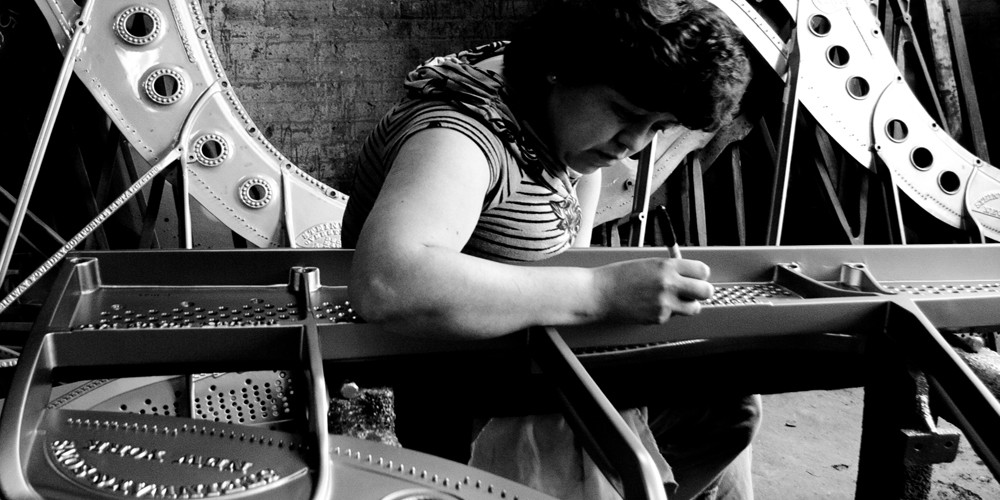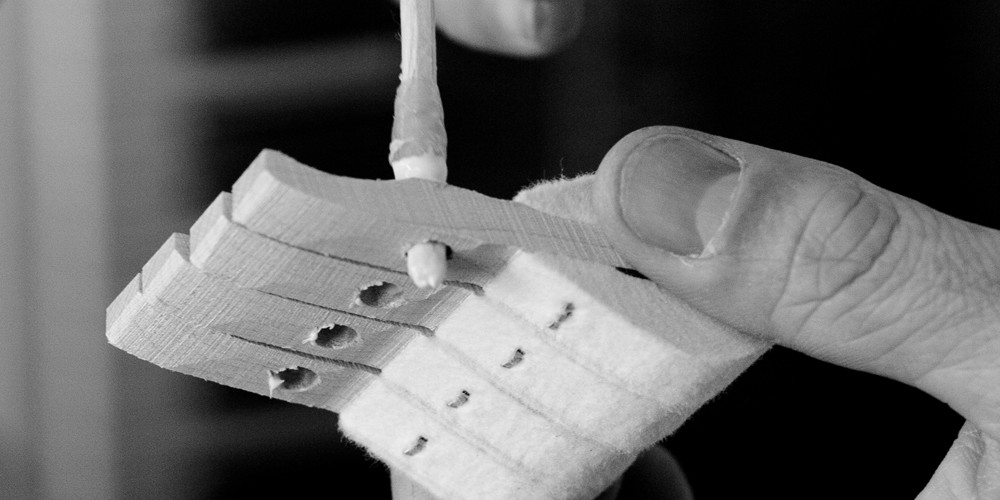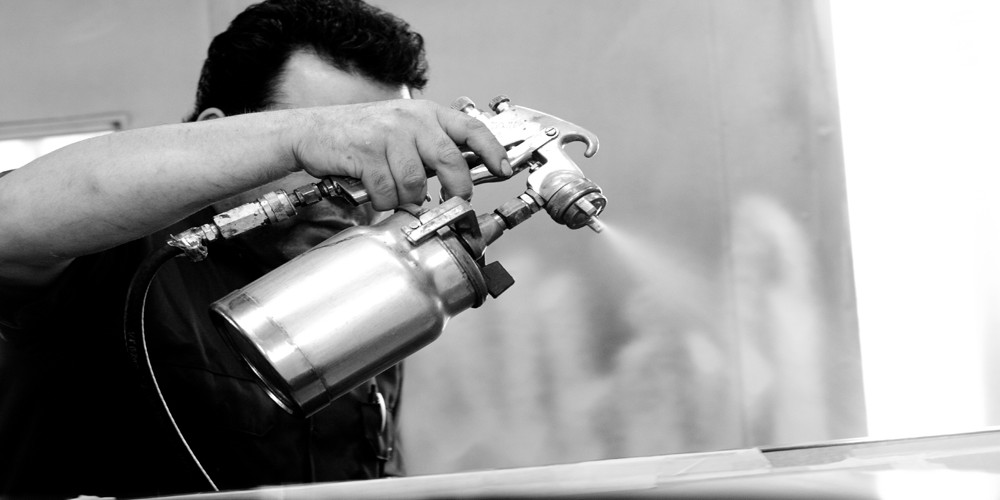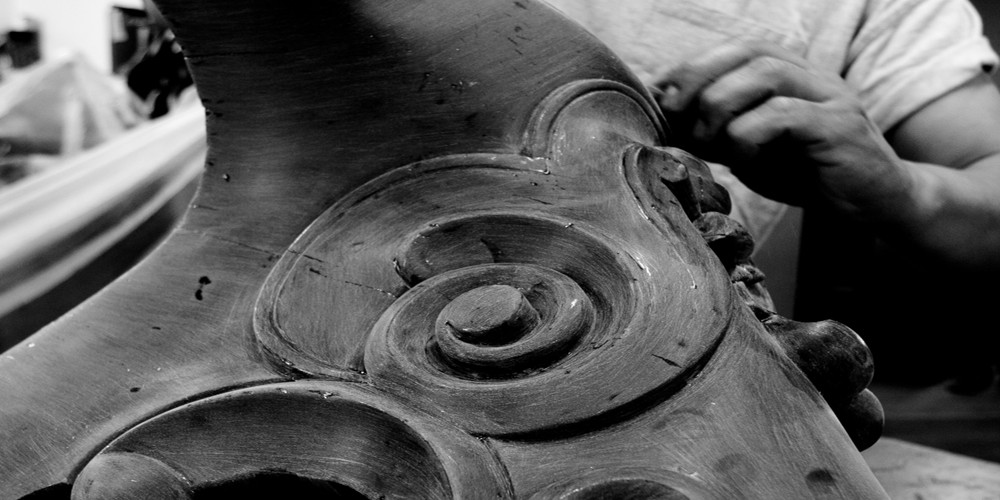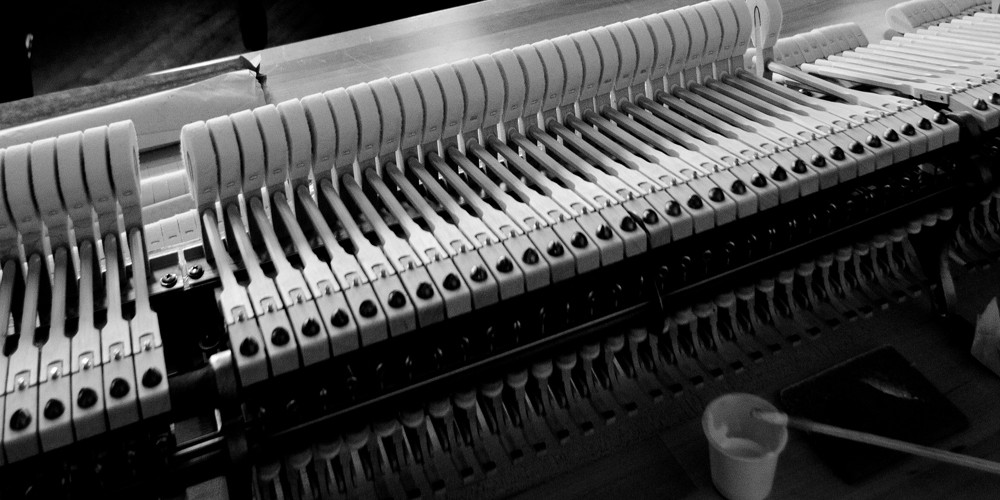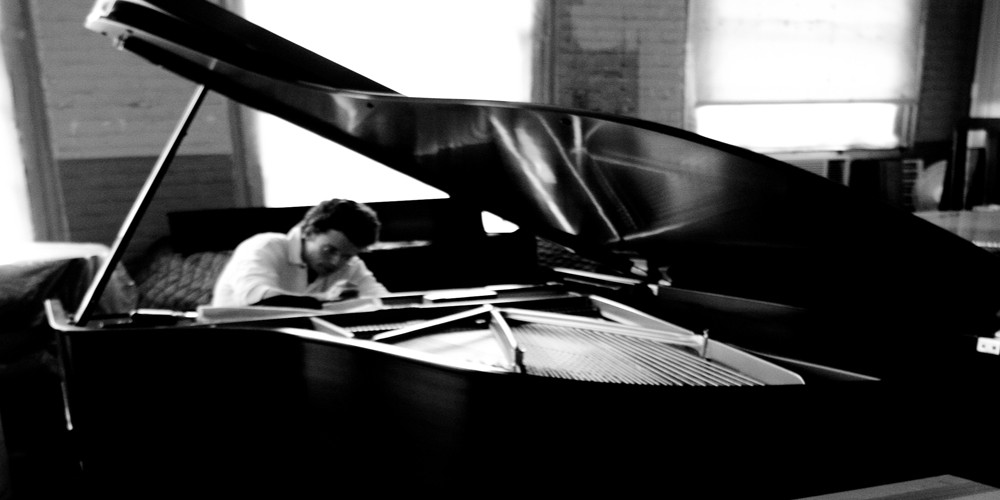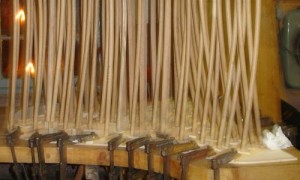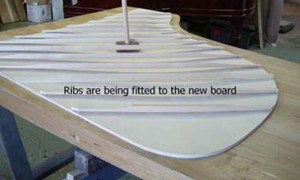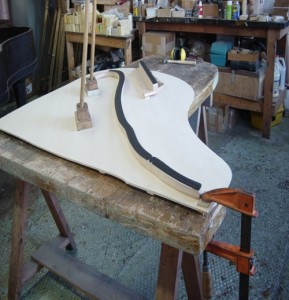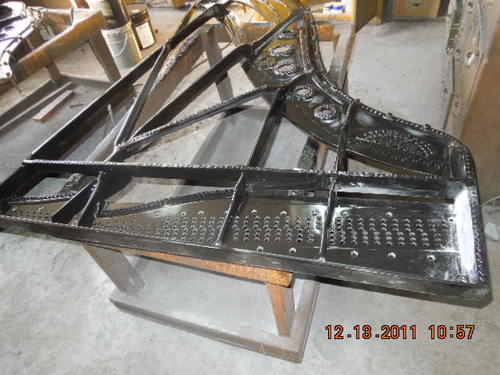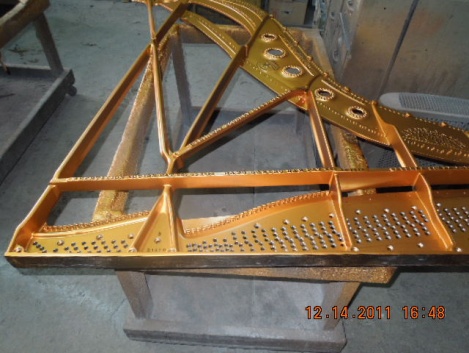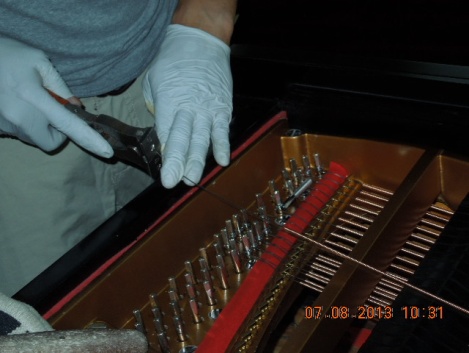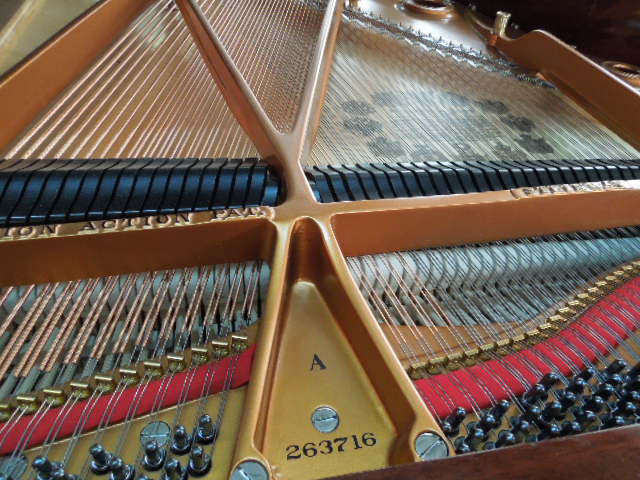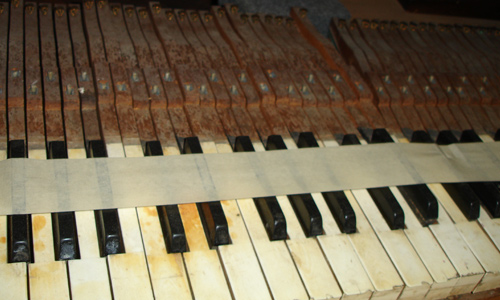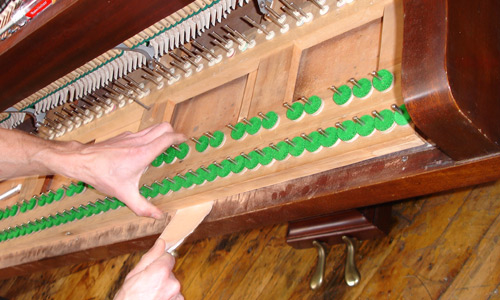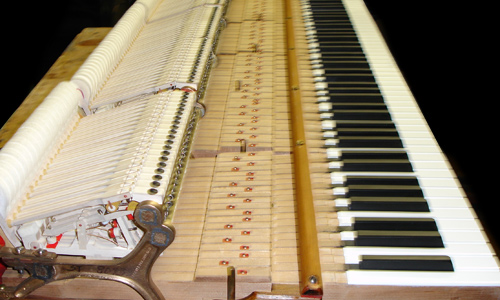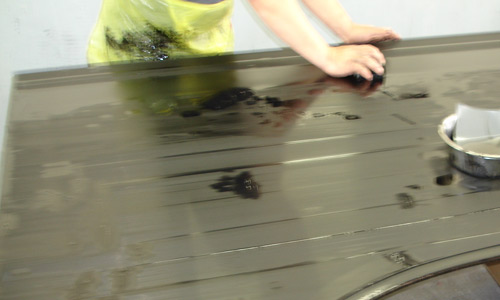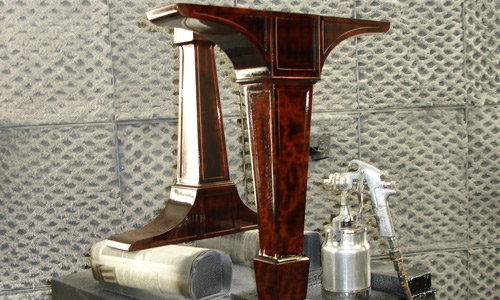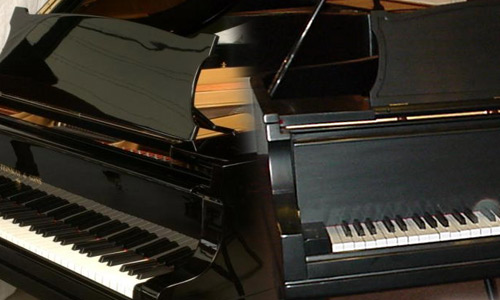Restoration – the work we do
The thorough restoration of your piano is a complex and beautiful thing, and at Cantabile, no shortcuts are taken. Our approach is a holistic one that takes into account the condition and performance ability of each component, no matter how small. We have skilled artisans who focus mainly on the style and architecture of our pianos. They are able to bring the original appearance back to life. The precision of every cut is enabled by their wide experience in creating unique works of art.
Refinishing the exterior of a piano is a very labor-intensive process, but the rewards can be amazing. Many of the veneers used on older pianos are almost impossible to find nowadays, and once the old, yellowed varnish or lacquer is removed, the real beauty of the wood emerges for the first time in years.
The piano case is disassembled and the parts are stripped of the old finish down to the bare wood. The parts are sanded, stained and sealed, then sprayed with several coats of lacquer, followed by sanding between coats. You can expect to be without the use of your piano for many weeks during this process. After refinishing thousands of pianos, we are still amazed each time by the transformation from what was formerly an ugly duckling of a piano into a swan-like grand.
There are several types of lacquers and finishes available, including lacquer, polyurethane, water-based finishes, and polyester. Finishes may be traditional satin, high polish or satin-luster, a type that offers a slight sheen without being overly shiny. A high gloss clear finish enhances wood grain because it acts as a lens to allow us to view the surface with reflective brilliance: Glossy finishes are not difficult to maintain, because simply wiping the instrument with a soft cloth keeps it polished.
For antique, highly-detailed, carved, or ornamented pianos, we offer true French polish finishing. This ancient hand-refinishing technique is performed by applying and buffing out multiple coats of alcohol-based shellacs, ultimately yielding a very thin, high gloss finish. Shellac flakes are dissolved and mixed in with denatured alcohol. The finisher applies coat after coat of shellac to “build” the finish to the desired thickness. French polishing is a difficult, labor-intensive skill, and we are very pleased with our mastery of it.
The vibration of a piano’s strings alone would be too quiet to be heard; their sound must be amplified. Piano strings, like those of a violin or a guitar, press down on a bridge which conducts their vibration to the large, thin piece of wood called the soundboard. Wooden ribs glued across the board, underneath, help spread the strings’ vibration throughout its mass.
While a crack in a violin body is a very serious matter, a crack in a piano’s soundboard can be repaired easily, without losing any of the piano’s tone quality.
Maintaining proper humidity during the winter heating season helps to prevent cracks from occurring.
The sound board is a five eighths inch thick wooden board in the back of the piano. On the back of it, it has one inch ribs which stabilize it by running against the grain of the sound board.
The traditional sound board is made of several five eighths thick boards which are glued side by side across the whole inside of the piano. It is the best sounding board, but with age, it can crack.
Our Sitka Spruce and Canadian Spruce soundboards are glued down to the perimeter of the piano case and bellied like a diaphragm in the center to best amplify the tone of the struck piano strings.
The soundboard is not flat as it appears. but has a crown held in place by a series of ribs. If the soundboard were flat or if it were to lose this crown, there would be very little volume or tone.
The ribs are made of a lightweight wood such as sugar pine, are double notched and fitted into soundboard lining. They are tapered to fit and correspond with the taper of the soundboard.
The soundboard in an upright piano often has its properties diminished since it is frequently situated against a wall and enclosed in its case.
Conversely, the soundboard of the horizontal grand has the advantage of open space between the bottom of the case and the floor as well as its opened top in a clearer more present sound.
The pinblock (or the wrestplank as it is sometimes called) is the block of wood that is behind the plate of the piano and holds the tuning pins tightly. It is one of the most important parts of the piano. Its job is to grip the tunning pins so that piano does not go out of tune.
In most grand pianos, the pinblock is not visible, but is directly underneath the tunning pin portion of the plate. It must be built strong enough to withstand the cumulative force of all of the strings pulling on the tuning pins.
Pinblocks do not always have to be replaced. There are seven different sizes of pins but size 1 or 2 works best. A lot depends on the age and condition of the pinblock and the piano itself.
As a piano ages it often suffers from the extremes in temperature and humidity, which can cause the tuning pins to become loose. This happens because the wood of the pinblock shrinks and the size of the hole into which the tuning pin is installed expands.
If only one or two tuning pins are loose, an appropriate repair is to remove the tuning pin and to replace it with a larger sized tuning pin, or to install a shim in the tuning pin hole.
Either of these repairs will provide enough friction to allow the piano to be tuned again.
Experienced craftsmen set the exact location of the pin and tuning-pins, as the cuts of the pin are all handmade.
The pin and its position are measured for each piano individually with special tools.
The pianos’s massive plate frame – sometimes referred to as the “harp”, is made of cast iron. The casting of a piano’s plate is a delicate science and art, since the dimensions are crucial and the iron shrinks by about one percent during cooling.
The strings of a piano individually have from 150 to 200 pounds of tension, and the cumulative forces acting on a piano can be anywhere from 20,000 to 40,000 pounds.
The piano is a stringed instrument. Its many parts are organized into five general structural and mechanical areas of either grand or vertical pianos.
These are: the case of the wing-shaped grand piano (or the cabinet of the vertical or upright piano); the soundboard and the ribs and bridges that are its components; the cast iron plate; the strings; and, collectively, the keys, hammers, and piano action or mechanism.
The case has many structural parts for attaching legs and tuning pins, but perhaps the rim and the keybed or shelf where the keys and piano action will be installed are most important.
The soundboard amplifies the vibrations of the strings, which are transmitted through bridges. The cast iron plate is installed over the soundboard and pinblock (part of the case), and it provides the strength to anchor the strings under tension.
Nose bolts and perimeter bolts anchor the plate to the braces and inner rim of the case. The 220 to 240 strings of the piano are attached to hitch pins along the curved edge of the cast iron plate and to tuning pins across the front of the piano, roughly parallel to the keyboard.
Much work is executed after its casting creation including drilling, sanding, sealing, agraffe installation and the customary as its final treatment.
Pressing a key on the piano’s keyboard causes a felt covered hammer to strike strings. The hammers rebound, allowing the strings to continue vibrating at their resonant frequency.These vibrations are transmitted through a bridge to a sounding board that couples the acoustic energy to the air so that it can be heard as sound.
When the key is released, a damper stops the string’s vibration.
The average modern piano has over 230 strings under a combined tension of 15 to 20 tons. A concert grand piano may have a combined string tension of up to 30 tons.
Pianos made in the eighteenth century were not as powerful and used low-tension wire made from an alloy different from the wire used today. Piano strings are made of high quality steel and must be able to endure years of extreme tension and fortissimo playing. Strings are manufactured in various diameters, with the thinnest wire employed in the highest treble while ascending in larger diameters down to the bass note section.
Broken piano strings need to be replaced quickly to reduce uneven wear on the hammer.
They can be replaced with a brand new string or repaired with a short piece of wire.
When restringing a piano with new strings, the steel strings are removed and carefully measured to determine what size of strings should be used for replacement. Bass strings must be removed and duplicated off-site and then replaced at a later date.
Please Note:
After a piano has been restrung, it should be tuned a minimum of four times the first year.
The working mechanism of the modern acoustic piano is made from the same materials as those used in the manufacturing of the first pianos – over 300 years ago. The main components of the action are wood and felt. Even the most famed and modern piano manufacturing facilities fully assemble the mechanism by hand.
Because of its construction, the piano action is liable to be affected not only by mechanical wear and tear, but also by the ever-changing temperature and humidity levels surrounding the piano.
In order to prolong the life of the action and its optimal performance, most manufacturers recommend that the action be regulated at least once every two years. Depending on the climate and use, the schedule may be more frequent.
Piano keys are generally made of spruce, sugar pine or basswood for lightness, yet maximum strength. Spruce is normally used in high-quality pianos.
Traditionally, the sharps/flats (black keys) were made from ebony and the naturals (white keys) were covered with strips of ivory, but since ivory-yielding species are now endangered and protected by treaty, fine plastics are now almost exclusively used.
When a piano is being regulated, rebuilt, or restored there are several details that frequently are overlooked in the process. One of the first things to be noticed when approaching a piano for the first time is the way the key tops look and feel. Often you can get an idea of the condition of the rest of the piano just from your first impression at the keyboard.
The keys are the pianist’s connection to the piano.
The keys must have a pleasing appearance and must feel good when your fingers touch them. There must not be too much friction, or the action will be sluggish; however, the keys must not be so loose that they wobble from side to side or make unwanted noise that would detract from the music.
Keyboard Replacement
Perhaps you have a vintage piano that has a number of problems with the keyboard, or perhaps the keyboard has been extensively damaged. In such a case, it is possible to replace the entire set of keys and key frame. However this is an expensive operation costing several thousand dollars and it is usually only suitable for pianos that are undergoing complete restoration.
Tuning
Piano tuning is the act of making minute adjustments to the tensions of the strings of a piano to properly align the intervals between their tones so that the instrument is in tune. The meaning of the term in tune in the context of piano tuning is not simply a particular fixed set of pitches. Fine piano tuning requires an assessment of the interaction between notes, which is different for every piano, thus in practice requiring slightly different pitches from any theoretical standard. We recommend that a piano be tuned at least twice each year.
However, it may be necessary to have ones piano tuned four times a year, at the change of each season if climate conditions are not ideal or that one simply retains sensitive ears.
Pianos are primarily created from wood, and are affected by climatic changes.
Changes in humidity result in the swelling and contracting of this wood, resulting in constant increases and decreases of string tension, thereby continually changing the “tuning.” Proper string tension and tuning must be consistently maintained.
People receive and maintain the best tone quality from their piano when it is tuned on a consistent basis. When a number of years pass between tunings, the pitch will often drop, far enough at times that two or more tunings will be necessary to restore the pitch to the proper level of Concert A-440/A-442 pitch.
When considering the refinishing of a piano, one must be aware of the various products and methods available, as well as what is appropriate to a particular piano.
Traditionally, the object of refinishing a piano is to restore the original look of the instrument. However, some people opt to change the color of the piano in order to have it fit in with the decor and the other furnishings in their homes.
The following itemizes the work for the furniture part of the piano:
1) Remove old finish
2) Clean wood and pores
3) Repair veneer and other damaged or missing wood pieces.
4) Sand surfaces
5) Stain wood
6) Apply multiple coats of high quality lacquer until pores are filled
7) Polish all surfaces to a satin or high gloss finish.
However, we usually do not recommend turning a piano that was made in Ebonized finish to a wood type finish as the grade of wood is usually not the type that is carefully matched.
There are several types of lacquers and finishes available on the market, including lacquer, polyurethane, water-based finishes, and polyester.
For antique, highly-detailed, carved, or ornamented pianos, we offer true French polish finishing.
This is a hand-refinishing technique performed by applying and buffing out multiple coats of alcohol-based shellacs, the way pianos were finished many years ago.
Our clients may choose the type of finish they prefer.
The finish may be a traditional satin, high polish or satin- luster, a type that offers a slight sheen without being overly shiny.
A high gloss clear finish enhances wood grain because it acts as a lens to allow us to view the surface with reflective brilliance: Glossy finishes are not difficult to maintain, because simply wiping the instrument with a soft cloth keeps it polished.
French polishing:
An ancient technique of wiping or rubbing shellac to apply a very thin high gloss finish. Shellac flakes are dissolved and mixed in with denatured alcohol.
French polishing is a difficult skill to master, and labor-intensive.The working mechanism of the modern acoustic piano is made from the same materials as those used in the manufacturing of the first pianos – over 300 years ago. The main components of the action are wood and felt. Even the most famed and modern piano manufacturing facilities fully assemble the mechanism by hand.

